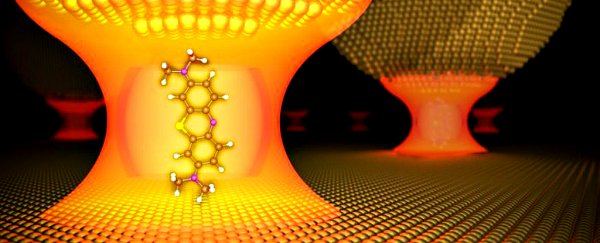In a lovely demonstration of light's quantum effects, physicists in the UK have just mixed a molecule with light at room temperature for the first time ever.
Light and matter are usually separate, with totally distinct properties, but now scientists have trapped a particle of light - called a photon - with a molecule in a tiny, golden cage of mirrors.
That's a big deal, because it creates a whole new way to manipulate the physical and chemical properties of matter, and could change the way we process quantum information.
This perfect mixing of light and a molecule - called 'strong coupling' - has been achieved before, but always through intense experiments at extremely cold temperatures.
By achieving this at room temperature, the researchers just made the process "chemically easily to access", which means they can now do cool stuff with it.
"We can now do a whole range of experiments on matter and light that would have been costly and difficult before. We could use light to change chemical structures, molecule by molecule," said one of the researchers, Ortwin Hess, from the Imperial College London. "It could also be useful in quantum technologies. Light carries quantum information, and we could use this strong coupling to copy the information over to matter and back."
Forgetting the applications for a second, what's also incredible about the achievement is that it's a pretty perfect demonstration of light's quantum effects.
"The experiment is a test that light is quantum in nature and indeed it showed the quantum effects we predicted," said Hess. "This is a remarkable crossing of theory and experiment. It's amazing how much nature behaves like the theory."
So how exactly do you get light and matter to mix? Molecules are capable of emitting photons - tiny blinks of light - when they change energy states. But usually once these photons are emitted, they never come back, and the two never mix again.
But, based on Hess's team's simulations, a team from the University of Cambridge was able to create a tiny trap, so small that when a molecule emits a photon, the photon can't escape.
This causes the energy to oscillate back and forth between the molecule and the photon over and over again, creating a mixed state that's part matter, part light.
This trap is sort of like a golden hall of mirrors. Known as a 'nanopore', it's a cavity only a billionth of a metre (or 1 nanometre) wide, which was formed between a tiny sphere of gold and a gold film.
The gold film creates a mirror image of the sphere, and when the researchers trapped a dye molecule in there they could position it in just the right way so that an emitted photon would become trapped. "The cavity is so small that light doesn't have a choice but to come together with matter," said Hess.
"It's like a hall of mirrors for a molecule, only spaced a hundred thousand times thinner than a human hair," added lead researcher Jeremy Baumberg from the University of Cambridge.
We're talking about physical processes on the incredibly tiny scale here, but the researchers were able to verify that strong coupling had been achieved by looking at the pattern of electromagnetic radiation being scattered by the molecule. When it split into two separated quantum states, the team could verify that the photons were taking less than a trillionth of a second to come back to the molecule.
Now that they've been able to achieve this process at room temperature, it opens up a whole new way of exploring the structure of matter and processes like photosynthesis, where plants are able to harness the energy of light to create energy. We're pretty excited to see what happens next.
The research has been published in Nature.
